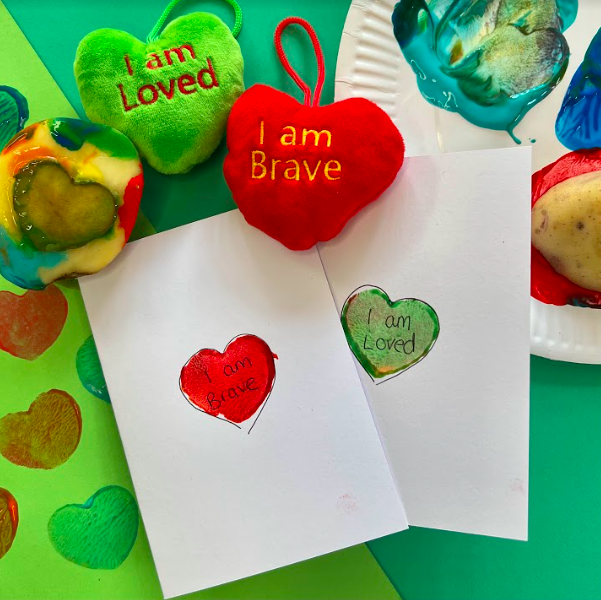A conversation with Julia, Hug-a-Bug World’s founder, on this occasion discussing a common
parenting challenge…
‘A Clingy Child’ … Signs your child may be struggling
“It’s ‘Children’s Mental Health week’ this week. Julia, tell us how to recognise the signs a child maybe experiencing mental health issues.
How a young child is feeling, is most likely expressed in their behaviour. In other words, verbalising their emotions is not an easy thing for them to do. Using stories, toys and drawing can help a child, access and understand what their feelings mean. This gives the parent/caregiver an opportunity to gently draw out, what maybe challenging their child’s mental well-being.
Here are some of the signs to look out for …
1. How does the child look? Observe their expressions. Are they different to usual?
2. Furthermore, are they becoming withdrawn?
3. Is there a change in how they take care of themselves eg. no longer getting dressed independently. Refusing to do things they would normally be happy to do.
4. Changes in academic ability (struggling at school or nursery), decrease in focus, easily distracted,
5. Changes in sleep pattern. Difficulty going to sleep. Waking up in the night? Not wanting to be
left alone.
6. Wetting themselves unexpectedly; bed wetting
7. In addition, are you noticing a lacking in excitement; refusal to do something they normally get enjoyment from?
“With regards to the things that you have mentioned here, some children can become clingy.
This can be before they go to nursery or school, before bedtime or if they’re around
unfamiliar people… what can we do to help them feel more independent, safe and secure?”
First of all, be assured that it’s very normal and common, for a child to be clingy at times of unfamiliarity.
How you respond to the clinginess, can determine whether or not, this behaviour may develop into a habit. You want to acknowledge, help and reassure your child but also encourage them to
find a way to deal with their feelings and help with their development of independence.
To understand better, the possible reasons behind a child being clingy or becoming clingy,
think about how you might feel, if you were your child given the same situation. This might enable you, to be more understanding of what your child needs, to know how to soothe and reassure them.
Your child is needing to feel close to you.
So, what is happening, that maybe causing your child
to feel insecure, frightened, uncomfortable, anxious, in need of cuddles, comfort, love and reassurance. It could be something, as simple as feeling tired and irritable but it could be something that they find hard or can’t express.
TIPS TO HELP YOUR CHILD FEEL SECURE
- Explain to them what is happening. Help them to understand how, why and what is happening or going to happen. Separation anxiety is very common. Your child needs to know you are not leaving them forever. Remember, your child doesn’t really have a concept of time, so help them by using something they can relate to eg, ‘when you have eaten your lunch and played with your friends, put your coat on and got your school bag, I will be back and we will go home together’.
- Implement the use of a transitional object.
What’s a transitional object?
It’s a soft toy, or any object that is portable and gives the child a sense of connection to the person or place they feel comfortable, safe and attached to. This helps with anxiety and the feelings of fear and separation.
Give your child the toy or object and explain that “every time you touch that {object}, I’ll be thinking of you…” or “if you start to
feel nervous then touch the {object} and it will help you feel less frightened, worried, anxious because it connects you to me ‘
Transitional objects are well documented in
psychology to be effective. The core purpose is to aid with the transition of your child from one environment to another.
This is why we created our affirmation hearts. They work well as they are pocket-sized and the right affirmation can
be chosen to link to the situation i.e ‘I am loved’ or ‘I am brave’ or ‘I can do it’…
What if the clinginess has lasted a long time with the nursery/school hand-over?
Going to a nursery or school and being clingy is understandable. Fear of the unknown. Meeting new children, negotiating a new environment, not knowing what’s expected of them. Any new situation, can evoke the need and desire for attachment to a comfort figure. It’s normal to feel a bit apprehensive, a bit anxious when we experience new things. We as adults can often feel the
same in certain scenarios.
Your child may have already attended nursery/school for a while and still they cling to you every time you leave them, leaving you feeling anxious and worried. Why is this happening and what can you do?
Patterns of behaviour are sometimes hard to break, as anything that is repeated enough, will become an automatic thought and action. In particular, a sensitive child, may find it even harder to separate
from their primary care figure, as they can feel things more acutely. Explanation, understanding, love
and reassurance are key to helping any child deal with separation, anxiety, fear and worry.
In due time, the child needs to learn, that it’s ok to be apart for a small amount of time. This can be encouraged by implementing a gradual transition, alongside using a transitional object. For example, let’s use the scenario of the child feeling they would not like to be alone at bedtime. You put your child to bed with their usual routine. You go to leave the room and they start to fret. Try this …… say ‘ I’m going to stand at the door and count to 30 seconds and then come back to you‘.
Each time you do this you lengthen the time before you go back to your child. Yes, I know it’s time consuming but you are breaking a habit and teaching your child, to depend on it’s self to feel safe and secure. Breaking a habit is not easy and for this reason often requires a change in the usual pattern of events. It’s worth the effort though. And you can help yourself persevere by knowing you are enhancing your child’s emotional development and understanding.
The goal is to develop a secure attachment in order to combat the clinginess. This also helps with their general mental health, encouraging the child to become securely independent.
Real Parent’s response to these techniques…
“My son had been struggling with going to his childminder. Owing to this, he became incredibly clingy and I would have to peel him off me kicking and screaming to hand him over. Due to this, I bought the pack of six affirmation hearts from Hug-a-Bug World and they have worked a treat with the handover. Our childminder keeps one of the hearts at her setting to give to my son when he arrives. This makes him so happy as he recognises it from our home. They have become his absolute comfort and they are small enough to come everywhere with us.”
“My Stepdaughter is autistic and she struggles before school with her anxiety. Since we
bought the hearts from Hug-a-Bug World, she tends to choose with ‘I am Brave’ or ‘I can do
it’, attaches to her book bag or pops one in her pocket and this serves as a reminder to her of
comfort. She does it every day and it has helped so much.”
Signs your child may be struggling
Find us on FACEBOOK
Follow us on INSTAGRAM
You may also like to read Building Self-Esteem in Children




